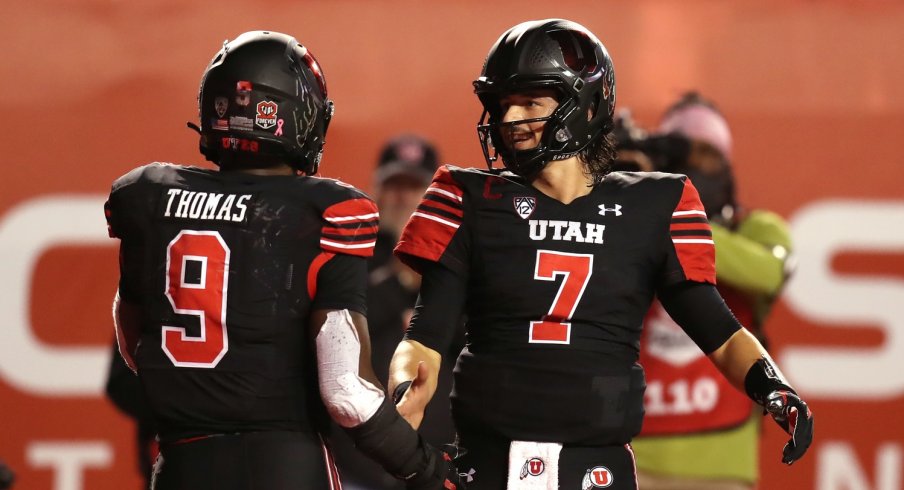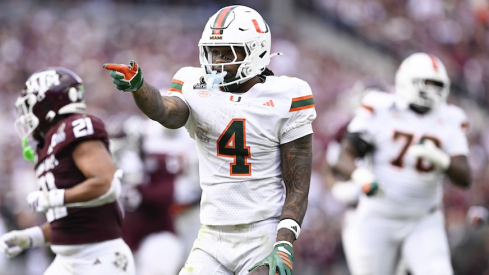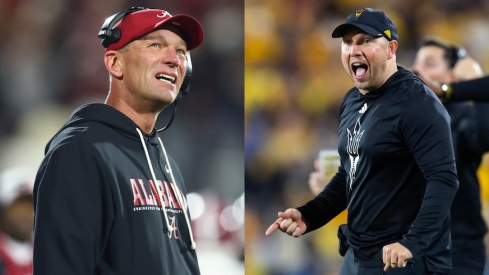In both of its losses this season, Ohio State's defense was the culprit upon which blame was deservedly pinned. But while Oregon and Michigan kept the Buckeyes on their heels by disguising diverse run games that opened up RPOs and play-action passes, it was the unit's general passivity that caught fans most off guard, rarely having seen the scarlet and gray get pushed around so easily.
While Utah may not seem on the surface to be the kind of program capable of manhandling Ohio State, Kyle Wittingham's team brings exactly the kind of physicality Ryan Day was likely hoping to avoid before formally handing over the reins to new coordinator Jim Knowles this offseason.
Much like the Buckeyes' most recent opponent and biggest rival, the Utes operate a pro-style system that incorporates a heavy dose of gap scheme runs and often utilizes two or three tight ends on the field at one time. Not only does this create a wall of mass to run behind, but the Utah offensive line executes its assignments with a nasty edge, as the pulling right guard does while kicking out a blitzing defender on this Counter play:
It certainly helps that the main ball-carrier behind this sturdy front is Tavion Thomas, a 6'2" 221 lb Ohio native who picked up 71% of his 1,041 rushing yards this season after contact (per Pro Football Focus). Many readers will remember the Dayton native from his time as a recruit, ultimately choosing to join Luke Fickell in Cincinnati after the Buckeyes pulled his offer late in the process.
After rushing for nearly 700 yards in 14 games as a Bearcat, Thomas transferred to Independence Community College in 2020 before landing in Salt Lake City this past fall. Despite seeing the field very little during a September stretch that saw the Utes drop back-to-back games against BYU and San Diego State, Thomas helped resurrect the Utah offense by running all over opponents in October and November.
With excellent vision to go along with his big frame, Thomas excelled in former Wisconsin coordinator Andy Ludwig's system that included countless subtleties. Instead of simply lining up and trying to smash opponents into submission, the Utes add plenty of little wrinkles, such as bunching three tight ends to one side on a Duo play and having the outside player (#80) fold inside to lead Thomas through the hole like a fullback.
Thomas' emergence coincided with that of quarterback Cameron Rising, himself a fellow transfer from a former OSU assistant, having originally committed to Tom Herman at Texas. After spending a year redshirting in Austin, Rising transferred to Utah and saw his first collegiate playing time in 2020, taking just nine snaps against USC before suffering a season-ending shoulder injury that also kept him out of spring practice.
Rising failed to win the starting job out of fall camp, with Baylor transfer Charlie Brewer taking the snaps on opening day after starting for four years in Waco. But the offense never gelled with Brewer under center, struggling to move the ball against BYU and in the first half of the San Diego State game. Though he wasn't able to lead a second-half comeback against the Aztecs, Rising never gave the job back after spelling Brewer in the third quarter of that game.
Part of the reason the offense improved with Rising at QB was due to his ability to run the football. Like his running back, the 230 lb Californian does most of his damage between the tackles, often dragging defenders for extra yardage.
With two ball carriers most comfortable working inside, Ludwig adds a handful of constraint plays to each week's game plan to keep the defense from loading up on the interior. That might take the form of handing off to star return man Britain Covey on an end-around behind what looks like a counter blocking scheme going the other way:
...or by loading up in 13 personnel (1 running back, 3 tight ends) and handing off to one of those tight ends on a jet sweep:
...or by running a flea-flicker off what first looks like an inside handoff on 4th & short:
But not all of Ludwig's wrinkles come in the form of gadget plays. Some are much more common, such as running an "access" or "leverage" screen to Covey instead of handing off on the called run play, simply because the cornerbacks gave too big of a cushion outside.
Ludwig will also give Rising post-snap reads as well, such as reading an unblocked defensive end for either a handoff or a quick bubble screen out of a bunch look:
Yes, once again that is a tight end catching the ball to make a play in space. While Covey is the most well-known Utah receiver and leads the team in receptions, the tight ends are the most productive members of Ludwig's passing game.
Brant Kuithe (#80) and Dalton Kincaid (#86) never seem to come off the field, yet the Utes will line them up all over the place to take advantage of their varied skillsets and create mismatches. Kincaid, the bigger of the two, will often line up at the in-line Y position but is still capable of making catches down the field and in traffic.
Kuithe (#80) is truly the queen on Ludwig's chessboard, however, filling a variety of roles from play to play and in many ways resembling Kyle Juszczyk of the San Francisco 49ers. We've already seen him act as a lead blocker, run a jet sweep, and catch a screen pass in this piece, but he's the Utes' most polished receiver down the field as well.
Ludwig will call concepts meant to open up Kuithe underneath as the primary target, such as this old west coast classic, known as a Texas concept:
Kuithe has blossomed into Rising's favorite target this fall, acting as a security blanket capable of finding seams in a zone. As such, Ludwig began lining him up in the slot like a traditional receiver, and is often the QB's first read in clear passing situations:
What the Utes lack in explosive game-breakers on the roster is made up for in scheme. Other than Covey, there aren't many players capable of turning a 5-yard catch into 50. Yet they have averaged 6.58 yards per play in games in which Rising has started at QB, a rate that would have placed them 15th nationally and more effective than any opponent Ohio State has faced this season.
When all the pieces are put together - an established, physical ground game; motioning in and out of gadget plays and screens to stretch the defense horizontally; finally adding a downfield receiving threat from the tight end spot - life becomes very difficult for opposing defenses.
With so much to look at and both the entire width and depth of the field to protect, defenders are forced to slow down and think, rather than quickly react to what they see. When those defenders are caught looking the Utes are more than happy to knock defenders on their backside, both literally and figuratively.
Such was the exact scenario in both of Ohio State's losses this season. Oregon attacked the edges with a variety of RPOs that undermined the basic structure of Kerry Coombs' defense and left the linebackers in no-win situations all afternoon. 10 weeks later, Michigan dialed up a diverse run game with enough window dressing to force those same linebackers to pause long enough for Wolverine blockers to get up to the second level and take them out of the play.
In order to avoid another embarrassment on national TV, the Buckeyes must win on early downs and force 3rd & long situations. Day harped on this fact both at halftime and following the loss in Ann Arbor, as the Wolverines always seemed to be in 2nd & 5 or 3rd & short situations, allowing them to unleash their brutal run game to keep the chains moving.
“They just stayed on schedule the whole time and that was the recipe I’m sure they had to win the game, and we weren’t able to stop that, and that’s really very disappointing,” Day said after the Michigan game. “Especially when you know they’re gonna do it."
For Utah, such a scenario will absolutely be the goal. While many are already focused on the Knowles era and what changes he'll bring to Ohio State's defense in 2022, the Buckeyes must be prepared for an attack that will try to expose the unit's weakest points one more time on January 1.



